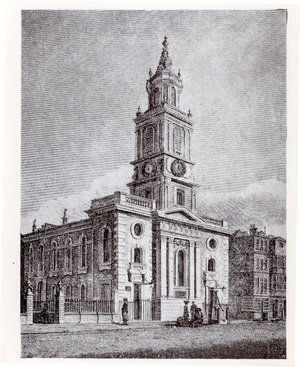Shakespeare in London
Talk led by Honorary President of the Shakespeare Birth
Trust, Professor Stanley Wells, on 'Shakespeare in
London'
25 May 2016, at St Botolph’s Hall, Bishopsgate, London, EC2M 3TL
Review by Ilaria Albani

St Botolph's in 1776
Every place has a past, but some places have more than a couple of fascinating stories to tell. In the heart of the City of London, near the glassy gigantic skyscrapers and the over-crowded station of Liverpool Street, there is the little church of St. Botolph-without-Bishopsgate. This church has witnessed the changes London underwent from the Middle Ages to the modern times and has always been connected to its literary life. Here the record of the burial of Ben Jonson’s son is kept and John Keats was baptised in 1795 and in Bishopsgate Shakespeare lived for some years in the late 1590s. It is not just a coincidence that in St. Botolph’s Hall, right behind the redbrick church, the Shakespearean scholar Stanley Wells tells the story of William Shakespeare’s London.
He starts speaking, his hands in his pockets while he stands behind the bookstand, and his authoritative calm voice brings our imagination four hundred years back in time, in the Elizabethan and Jacobean city in which the celebrated playwright lived and wrote his most famous plays. From the 1590s, London has been the centre of Shakespeare’s life. The royal court resided in the capital and many times he performed for Elizabeth I – the last time two months before she died in 1603 – and for James I, who changed the name of Shakespeare’s ‘playing company’ Lord Chamberlain’s Men into King’s Men, and gained money and honour.
In London, he met many important people, like the Earl of Southampton – to whom he dedicated the two narrative poems Venus and Adonis and The Rape of Lucrece (and allegedly his sonnets) – and he worked with his fellow actors and playwrights at The Theatre and The Curtain in Shoreditch and at the Globe, the Southbank theatre of which he held a share. On these stages, Shakespeare presented London itself, covertly and distanced in time and space in the tragedies and comedies of romantic and mythic taste or more directly in the historical plays. It was to use the strong connection between fiction and contemporary reality that in 1601 the Earl of Essex asked Shakespeare’s company to stage Richard II at the Globe Theatre in the hope of stirring revolutionary sentiments in the people and attempting a rebellion against the queen the day following the representation. The rebellion was unsuccessful and the Earl of Essex was beheaded in the Tower of London after being condemned at his trial at Westminster Hall.
In the same hall, Shakespeare was summoned as a witness in the case Bellot versus Mountjoy concerned with a marriage financial settlement in 1612. The Mountjoys hosted Shakespeare in their house for some time in the years when he was continually moving throughout the city. Despite the considerable time he spent in London, he always felt his hometown, Stratford-upon-Avon, to be his home and here he used to come back often and owned a substantial estate where he retired before his death.
Nowadays, the most important memorial we have is Shakespeare’s First Folio, where his friends John Heminges and Henry Cordell gathered all his plays gifting the posterity with the Bard’s work. In it his art stays alive, but the city as well preserves the traces of his passage. Every place has its stories and it is just magical to realise that London still speaks of William Shakespeare.

